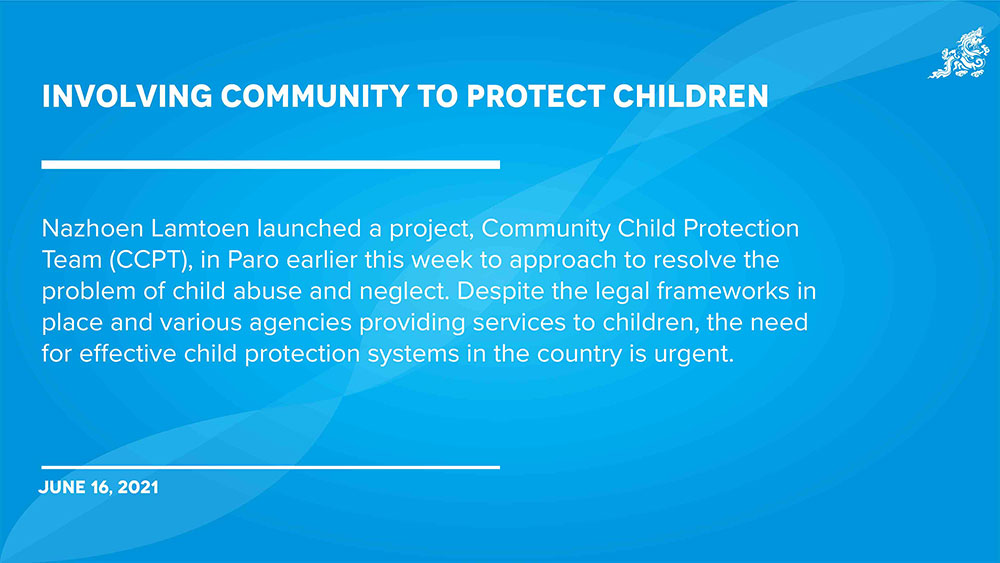Despite having legal frameworks and numerous agencies providing services to children in need of care and protection, there is still a need for an effective child protection system in the country.
This according to officials with Nazhoen Lamtoen was because children are vulnerable and the biggest challenge in eliminating violence against children is because cases go unreported.
Nazhoen Lamtoen launched a project, Community Child Protection Team (CCPT), in Paro earlier this week to identify and respond to gaps.
CCPT is a group of community representatives, who will promote the approach to resolve the problem of child abuse and neglect.
A team will be formed within each gewog comprising gups, prominent members and youth representatives to monitor, assess, support and report any abuses to the dzongkhag women and child committee.
According to the executive director of Nazhoen Lamtoen, Thinley Tobgyel, the project would kickstart from ten gewogs in Paro after training the local leaders and community about the concept.
He said that the team would meet monthly to update on any issues facing the children in the community. “Coordinator of Nazhoen Lamtoen will support and monitor the team.”
Nazhoen Lamtoen’s office in Paro supported 36 children and youth in difficult circumstances during the nationwide lockdown.Records available revealed 49 students dropped out of schools, nine were raped, and 14 boys are suspected of underage rape cases in Paro.
Thinley Tobgyel said that while children in remote communities faced scores of protection issues, these children suffer in silence as they are not aware of their rights, where to report and seek support. “Those aware of such supports fail to report as they are inaccessible due to remoteness.”
He said Nazhoen Lamtoen would form another Child Protection Team (CPT) in schools considering significant physical violence (corporal punishment) faced by the students.
Child-led groups will be formed in schools, ensuring children’s voices and providing a comfortable platform to encourage children in difficult circumstances to share their grievances, he said.
Record highlights 64 percent of children are victims of physical violence and have experienced some form of physical violence at least once in their lifetime.
In addition, physical violence was associated with corporal punishment used by parents, caretakers and other relatives. In the meantime, 44.8 percent faced physical violence before reaching 13 years and 54.7 percent face physical violence in schools.
Another official with Nazhoen Lamtoen said that there were many unreported violence cases in schools, and not many were aware of support groups in dzongkhag. “The team aims to discourage children coming in conflict with the law by providing timely support.”
Officiating Paro dzongdag, Kinley Gyeltshen, said that if family members perpetrated violence, abuse, and extreme punishment, it creates a risk for the family, as the perpetrator is the only breadwinner discouraging the family from reporting the case.
Thinley Tobgyel said CCPT would help the family by providing basic facilities and help start small businesses to enhance their livelihood.
He said that it was important for the community to be actively involved in preventing and responding to more hidden forms of abuse that are often perpetrated by teachers, staff or other adults in positions of trust.
The team is expected to identify vulnerable children and families and establish practical steps to reduce those risks, including reporting mechanisms.
Thinley Tobgyel said that establishing community-based child protection groups were aimed at creating awareness among residents within a community of their responsibility for protecting children. “When the community becomes aware of such groups and services, the gewog will lead the approach.”
He said that local leaders and community members would be trained and briefed about the Child Protection Act, report mechanism, early identification and safety referral, among others. “By 2023, we will have 205 CCPT and CPT in schools.”
The project is funded by Save the Children.
By Phub Dem | Paro
Edited by Tashi Dema


